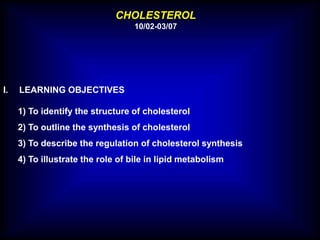
Cholesterol.ppt
- 1. CHOLESTEROL 10/02-03/07 I. LEARNING OBJECTIVES 1) To identify the structure of cholesterol 2) To outline the synthesis of cholesterol 3) To describe the regulation of cholesterol synthesis 4) To illustrate the role of bile in lipid metabolism
- 2. II. OVERVIEW A) Cholesterol – cell membrane, precursor of bile salts and acids, steroid hormones B) Sources of cholesterol (Fig. 18.1) 1) Influx a) diet b) extrahepatic synthesis c) hepatic synthesis 2) Efflux a) free cholesterol in bile b) bile salts/ acids c) VLDL C) Influx is not precisely balanced by efflux, leading to coronary artery disease (CAD)
- 3. III. STRUCTURE A) General (Fig. 18.2) 1) hydrophobic 2) has 4 fused rings, A, B, C, D (“steroid nucleus”) 3) 8C, branched hydrocarbon chain attached at C-17 on D ring 4) ring A has a C-3 hydroxyl group 5) Ring B has double bound between C-5 and C-6 B) Sterols 1) steroids with 8-10 carbons at C-17 2) hydroxyl group at C-3 C) Cholesteryl esters 1) fatty acid esterified and C-3 2) more hydrophobic than free cholesterol 3) not found in membranes 4) most abundant form in plasma 5) most be transported in lipoprotein particle in blood
- 4. IV. CHOLESTEROL SYNTHESIS A) Occurs in virtually all tissues B) Highest in liver, intestine, adrenal cortex, and reproductive tissues C) Basic building block is acetate D) Reductant is NADPH E) Driven by hydrolysis of thioester bond of acetyl CoA and of terminal phosphate of ATP F) Enzymes are in cytoplasm and ER G) Regulated by cholesterol levels H) Synthesis of HMG CoA (Fig. 18.3) 1) first 2 reactions – similar to those seen in ketone body synthesis 2) the HMG-CoA synthase is cytosolic cytoplasmic
- 5. I) Committed, rate-limited step is catalyzed by HMG CoA reductase 1) HMG CoA converted to mevalonic acid 2) CoA released 3) NADPH used for the biosynthetic reductant 4) enzyme is highly regulated 5) ER-associated enzyme facing the cytoplasm 6) the target of statin drugs
- 6. J) Mevalonate is phosphorylated twice using ATP to yield 5- pyrophosphomevalonate K) Decarboxylation (ATP-dependent) results in 5C isopentenyl pyrophosphate (IPP) L) Isomerization of IPP results in 3,3 dimethylallyl pyrophosphate (DPP) M) DPP + IPP yields geranyl pyrophosphate (GPP). Released PPi is hydrolyzed to 2 Pi by ubiquitous pyrophosphatase N) GPP + IPP yields farnesyl pyrophosphate (FPP) O) FPP + FPP, followed by reduction by NADPH yields squalene P) series of oxidation and reduction reactions yield lanosterol Q) multistep, complicated reactions convert lanosterol to cholesterol R) note the use of 5C building blocks
- 7. V. REGULATION OF CHOLESTEROL SYNTHESIS A) Major regulatory point is HMG CoA reductase (Fig. 18.6) B) Expression of the HMG CoA reductase gene is stimulated by sterol- regulatory element binding protein, SREBP, binding to SRE in the promoter – high cholesterol blocks SREBP cleavage from the ER. SREBP stays in the cytoplasm and HMG CoA reductase gene transcription is reduced (negative feedback) C) Sterol-independent phosphorylation/dephosphorylation – Phospho form is inactive. High AMP (low ATP levels) – low cholesterol synthesis. Dephospho form (high ATP) is active. D) High insulin levels – the expression of the HMG CoA reductase gene is increased. Glucagon lowers transcription of the HMG CoA reductase gene.
- 8. F) Statin drugs are, reversible, competitive inhibitors of HMG CoA reductase (Fig. 18.7) VI. DEGRADATION OF CHOLESTEROL – converted to bile acids and salts VII. BILE ACIDS AND SALTS A) Structure of bile acids (Fig. 18.8) 1) 24 carbon atoms 2) 2 or 3 hydroxyl groups 3) side chain ends with a carboxyl group 4) pKa of carboxyl is 6.0 5) amphipathic (hydroxyl groups in b configuration, above the rings and methyl groups are in the a configuration, below the rings) – this is why they act as emulsifying agents
- 9. B) Synthesis of bile acids (Fig. 18.9) 1) liver, multistep process starting with cholesterol 2) hydroxyl groups inserted, double bond in B ring reduced, hydrocarbon chain shortened by three carbons, carboxyl group added to end of chain 3) rate-limiting committed step catalyzed by cholesterol 7-a hydroxylase (feedback inhibited by cholic acid, stimulated by cholesterol) 4) most common products are “primary” bile acids – cholic acid and chenodeoxycholic acid (Fig. 18.8) C) Synthesis of bile salts (Fig. 18.10) – conjugation of glycine or taurine on bile acids. Most common are glycocholic and glycocheno- deoxycholic acids, and taurocholic and taurocheno- deoxycholic acids. Bile salts are more acidic (lower pKa) and better emulsifiers.
- 10. D) Bacterial flora in the gut can remove glycine and taurine and regenerate bile acids. They can also convert some of the “primary” bile acids to “secondary” bile acids by removing a hydroxyl group to produce deoxycholic acid and lithocholic acid. E) Cholesterol levels can be lowered by increasing the excretion of bile acids and salts. Cholestyramine and dietary fiber bind bile acids and salts and stimulate their excretion. This draws the biosynthetic pathway forward and lowers the serum level of the precursor, cholesterol. This helps lower the risk of coronary artery disease.